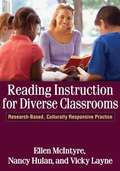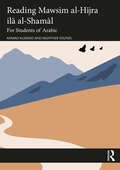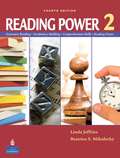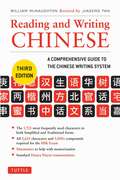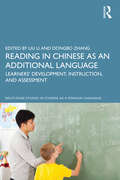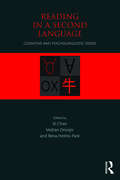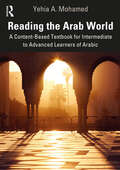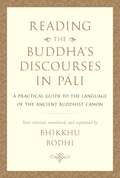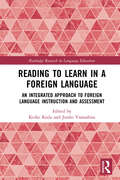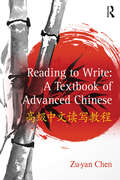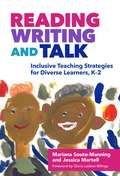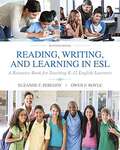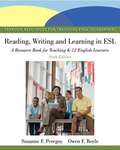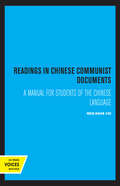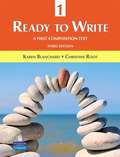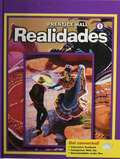- Table View
- List View
Reading Instruction for Diverse Classrooms
by Nancy Hulan Ellen McintyreThis practical, teacher-friendly book provides indispensable guidance for implementing research-based reading instruction that is responsive to students' diverse cultural and linguistic backgrounds. Structured around the "big five" core topics of an effective reading program phonemic awareness, phonics, fluency, vocabulary, and comprehension the book explains tried-and-true teaching strategies for fostering all students' achievement. Key topics include engaging diverse students in classroom discussion, involving families in learning, and assessing and teaching new literacies. Numerous classroom examples demonstrate a wide range of easy-to-implement lesson ideas and activities for students at different grade levels, including struggling learners. Issues specific to English language learners are woven throughout the chapters.
Reading Mawsim al-Hijra ilā al-Shamāl: For Students of Arabic
by Munther Younes Ahmad AlswaidReading Mawsim al-Hijra ilā al-Shamāl: For Students of Arabic is intended for advanced students of Arabic who have studied the language for at least two years at college level or the equivalent. The book is based on Tayeb Salih’s novel Mawsim al-Hijra ilā al-Shamāl, a masterpiece in modern Arabic literature. This book is designed to accompany the novel, which the authors divided into 60 parts, each of which consists of 400–500 words of the original text. A lesson is built on each part and starts with a reference to the first and last sentences in it. This is followed by a list of new vocabulary and a variety of activities and exercises, some oral and some written, whose goal is to develop students’ listening, speaking, reading, and writing skills and knowledge of Arabic language, culture, and literature. The book ends with a glossary of literary terms. The book’s e-resources include a comprehensive glossary of words arranged by root, a glossary of expressions, and other resources. The book can be used as a main or a supplementary text in an Arabic language course or for independent study.
Reading Medieval Latin
by Keith SidwellReading Medieval Latin is an introduction to medieval Latin in its cultural and historical context and is designed to serve the needs of students who have completed the learning of basic classical Latin morphology and syntax. (Users of Reading Latin will find that it follows on after the end of section 5 of that course. ) It is an anthology, organised chronologically and thematically in four parts. Each part is divided into chapters with introductory material, texts, and commentaries which give help with syntax, sentence-structure, and background. There are brief sections on medieval orthography and grammar, together with a vocabulary which includes words (or meanings) not found in standard classical dictionaries. The texts chosen cover areas of interest to students of medieval history, philosophy, theology, and literature.
Reading Power 2 (Fourth Edition)
by Beatrice S. Mikulecky Linda JeffriesReading Power 2 is a new and updated edition of the successful student-centered reading skills textbook Reading Power. Its unique structure, featuring four parts to be used concurrently, allows low-intermediate-level students (with a 600-word vocabulary) to develop the multiple sills and strategies involved in the reading process. Overview Extensive Reading helps students to build reading fluency, broaden knowledge of vocabulary and collocation, and gain confidence. Vocabulary Building offers strategies for independent vocabulary learning such as dictionary work, guessing meaning from context, and learning how words work in sentences. Comprehension Skills teaches reading skills such as recognizing words and phrases, scanning for information, and making inferences. Reading Faster builds awareness of reading speed, provides strategies and exercises for increasing speed, and offers charts for tracking progress. New to the Fourth Edition An updated Extensive Reading section with a unit on fiction and non-fiction reading, more activities for evaluating student progress, and a revised suggested reading list Enhanced vocabulary features including new "Focus on Vocabulary" exercises and an expanded Vocabulary Building section There is also a Teacher Guide with Answer Key and a Test Booklet for Reading Power 2. The Reading Power series also includes: Basic Reading Power 1 (Third Edition): Beginning Reading Power 2 (4th Edition): Intermediate More Reading Power 3: High-Intermediate Advanced Reading Power 4: Advanced
Reading and Writing Chinese
by William Mcnaughton Jiageng FanThis is a compete and easy-to-use guide for reading and writing Chinese characters.Used as a standard by students and teachers in learning Chinese for more than three decades, the bestselling Reading & Writing Chinese has been completely revised and updated. Reading & Writing Chinese places at your fingertips the essential 1,725 Chinese characters' up-to-date definitions, derivations, pronunciations, and examples of correct usage by means of cleverly condensed grids. This guide also focuses on Pinyin, which is the official system to transcribe Hanzi, Chinese characters, into Latin script, now universally used in mainland China and Singapore. Traditional characters (still used in Taiwan and Hong Kong) are also included, making this a complete reference.Newly updated and revised, these characters are the ones officially prescribed by the Chinese government for the internationally recognized test of proficiency in Chinese, the Hanyu Shuiping Kaoshi (HSK). Key features of this newly-expanded edition include:The 1,725 most frequently used characters in both Simplified and Traditional formsAll 2,633 characters and 5,000+ compounds required for the HSK ExamMnemonics to help with memorizationStandard Hanyu Pinyin romanizations More mnemonic phrases and etymologies to help you remember the characters An extensive introduction, alphabetical index, and index according to stroke count and stroke order Completely updated/expanded English definitions Convenient quick-reference tables of radicals Updated and revised compounds, plus 25% more vocabulary now offered Codes to assist those who are preparing for the AP exam or the HSK exam
Reading and Writing Chinese
by William Mcnaughton Jiageng FanThis is a complete and easy-to-use guide for reading and writing Chinese characters.Learning written Chinese is an essential part of mastering the Chinese language. Reading & Writing Chinese places at your fingertips the essential 1,725 Chinese characters' up-to-date definitions, derivations, pronunciations, and examples of correct usage by means of cleverly condensed grids.Newly updated and revised, these characters are the ones officially prescribed by the Chinese government for the internationally recognized test of proficiency in Chinese, the Hanyu Shuiping Kaoshi (HSK). The student's ability to read Chinese and write Chinese are reinforced throughout.Key features of this newly-expanded edition include: The 1,725 most frequently used characters in both Simplified and Traditional forms. All 2,633 characters and 5,000+ compounds required for the HSK Exam. Standard Hanyu Pinyin romanizations. More mnemonic phrases and etymologies to help you remember the characters. An extensive introduction, alphabetical index, and index according to stroke count and stroke order. Completely updated/expanded English definitions. Convenient quick-reference tables of radicals. Updated and revised compounds, plus 25% more vocabulary now offered. Codes to assist those who are preparing for the AP exam or the HSK exam.
Reading in Chinese as an Additional Language: Learners’ Development, Instruction, and Assessment (Routledge Studies in Chinese as a Foreign Language)
by Dongbo Zhang Liu LiReading in Chinese as an Additional Language focuses on Chinese literacy acquisition, which has been considered most difficult by both learners and teachers of Chinese as an additional language (CAL). Three major areas are covered: (1) acquisition of Chinese characters; (2) reading comprehension subskills and reader’s identity; (3) reading instruction and assessment. The first part delves into the foundation of Chinese literacy development—how to learn and teach Chinese characters. The second part examines various learners’ reading comprehension subskills, as well as the evolution of learners’ literacy identity. The third part explores effective instructional methods and assessment practices for CAL reading development. Theoretically, this book provides frameworks and evidence from both cognitive and sociocultural perspectives on the nature of CAL reading development. Pedagogically, the book showcases how to teach and assess CAL reading skills. Methodologically, this book includes empirical studies using both qualitative and quantitative methods. In terms of scope, the book covers a much broader spectrum of issues about CAL reading research and classroom teaching than has previously been available. Writing is also discussed in several chapters. In terms of technology, the book includes discussion on how the use of computers, the Internet, and social media impacts students’ Chinese literacy acquisition. This book will help CAL researchers and educators better understand the nature of CAL reading development and become well informed about CAL classroom teaching and assessment, including the application of interactive approaches to teaching and assessing diverse reading skills.
Reading in a Second Language: Cognitive and Psycholinguistic Issues
by Xi Chen Rena Helms-Park Vedran DronjicReading in a Second Language offers a comprehensive survey of the phenomenon and process of reading in a second language, with graduate and upper-level undergraduate students in second language acquisition, psycholinguistics, and applied psychology as its primary audience. The book explores reading processes from a number of complementary standpoints, integrating perspectives from fields such as first and second language reading, second language acquisition, linguistics, psycholinguistics, and cognitive neuroscience. The first half examines major factors in second language reading: types of scripts, the cognitive and neural substrates of reading; metalinguistic awareness, word recognition, language transfer, and lexical knowledge. The second part of the book discusses the social and educational contexts in which reading development occurs, including issues related to pedagogy, the use of technology in the classroom, reading disorders, and policy making. Reading in a Second Language provides students with a full, logically organized overview of the primary factors that shape reading development and processes in a second language.
Reading the Arab World: A Content-Based Textbook for Intermediate to Advanced Learners of Arabic
by Yehia A. MohamedReading the Arab World is a content-based textbook for intermediate to advanced students of Arabic, designed to enhance language skills through exposure to authentic texts. Students will develop their reading, writing, speaking, and critical thinking skills as they learn about the most contemporary issues shaping the Arab world through a range of authentic texts. The choice of texts and authors is diverse and includes texts from various sources and geographical regions in the Arab world, as well as authors of different genders, ages, generations, and schools of thought, thus ensuring a compelling range of viewpoints and angles. Each text is supported by relevant tasks such as vocabulary exercises, comprehension activities, and discussion questions. This is an ideal resource for students of Arabic as a second or heritage language, working at or above the Intermediate-High level on the ACTFL proficiency scale.
Reading the Buddha's Discourses in Pali: A Practical Guide to the Language of the Ancient Buddhist Canon
by Bhikkhu BodhiRenowned scholar-monk and bestselling translator Bhikkhu Bodhi&’s definitive, practical guide on how to read ancient Buddhist texts in the original language.Bhikkhu Bodhi&’s sophisticated and practical instructions on how to read the Pali of the Buddha&’s discourses will acquaint students of Early Buddhism with the language and idiom of these sacred texts. Here the renowned English translator of the Pali Canon opens a window into key suttas from the Sa?yutta Nikaya, giving a literal translation of each sentence followed by a more natural English rendering, then explaining the grammatical forms involved. In this way, students can determine the meaning of each word and phrase and gain an intimate familiarity with the distinctive style of the Pali suttas—with the words, and world, of the earliest Buddhist texts. Ven. Bodhi&’s meticulously selected anthology of suttas provides a systematic overview of the Buddha&’s teachings, mirroring the four noble truths, the most concise formulation of the Buddha&’s guide to liberation. Reading the Buddha&’s Discourses in Pali shares with readers not only exceptional language instruction but also a nuanced study of the substance, style, and method of the early Buddhist discourses.
Reading to Learn in a Foreign Language: An Integrated Approach to Foreign Language Instruction and Assessment (Routledge Research in Language Education)
by Keiko Koda Junko YamashitaThis book describes a theory-guided approach to Foreign Language (FL) course development, implementation, instruction and assessment. It documents the development and implementation of a theory-guided approach designed to exploit cross-linguistically sharable competencies as resources for promoting FL learning. The volume delineates the processes of (a) identifying cross-linguistically sharable competencies, (b) exploring ways of exploiting sharable competencies as resources in promoting language skills through their purposeful use for content learning, (c) implementing the instructional approach in multiple EFL classrooms, and (d) evaluating the approach by comparing learning outcomes across classrooms. It presents a solid conceptual framework that integrates theories in multiple research domains, including second language acquisition, knowledge acquisition, and language assessment. It also provides detailed descriptions of framework construction and classroom implementation – the two processes that are integral to course design and development.
Reading to Write: A Textbook Of Advanced Chinese
by Zu-Yan ChenTraditionally, reading and writing are believed to be separate but related language processes and teachers follow the conventional wisdom of teaching in-depth reading, with writing as a tag-on issue. Therefore, there exists an increasingly urgent call for a well-rounded reading-writing curriculum and a theoretically-informed, empirically-based, student-centered advanced textbook that aims to develop the synergy between reading and writing. Reading to Write: A Textbook of Advanced Chinese is intended to fill this significant gap. It treats reading and writing as integrative parts and interactive skills in Chinese language teaching, putting them hand-in-hand, supplementing each other.
Reading, Writing, And Talk: Inclusive Teaching Strategies For Diverse Learners, K-2 (Language And Literacy)
by Gloria Ladson-Billings Mariana Souto-Manning Jessica MartellThis book invites readers to consider ways in which their language and literacy teaching practices can better value and build upon the brilliance of every child. In doing so, it highlights the ways in which teachers and students build on diversities as strengths to create more inclusive and responsive classrooms. After inviting readers to consider and better understand the diverse language and literacy practices of diverse chidlren, it offers invitations for teachers to make these practices foundational in their own classrooms and to consider meaningful possibilities for learning authentically with young children in primary grades. It features chapters that focus on oral language, reading, and writing development, all while recognizing that these are not separate. In each of these chapters, readers are invited to consider diverse possibilities, perspectives, and points of view in practice within primary grades classrooms. Throughout, it offers ways to foster classroom learning communities where racially, culturally, and linguistically diverse chidlren are supported and valued.
Reading, Writing, and Learning in ESL: A Resource Book for Teaching K-12 English Learners
by Suzanne Peregoy Owen BoyleThis book is the ideal source for teaching oral language, reading, writing, and the content areas in English to K-12 English learners. In an approach unlike most other books in the field, Reading, Writing, and Learning in ESL looks at contemporary language acquisition theory as it relates to instruction and provides detailed suggestions and methods for motivating, involving, and teaching English language learners. Praised for its strong research base, engaging style, and inclusion of specific teaching ideas, the book offers thorough coverage of oral language, reading, writing, and academic content area instruction in English for K-12 English learners. Thoroughly updated throughout, the new edition includes a new chapter on using the Internet and other digital technologies to engage students and promote learning, many new teaching strategies, new and revised activities, and new writing samples.
Reading, Writing, and Learning in ESL: A Resource Book for Teaching K-12 English Learners (6th Edition)
by Suzanne F. Peregoy Owen F. BoyleReading, Writing, and Learning in ESL: A Resource Book for Teaching K-12 English Learners, Sixth Edition, is a comprehensive, reader-friendly resource book that provides a wealth of teaching ideas for promoting oral language, reading, and writing development in English for K-12 English learners. The book provides up-to-date language acquisition theory, classroom organization, teaching strategies, and assessment procedures for effective English learner instruction.
Readings in Chinese Communist Documents: A Manual For Students Of The Chinese Language (classic Reprint)
by Wen-Shun ChiThis title is part of UC Press's Voices Revived program, which commemorates University of California Press’s mission to seek out and cultivate the brightest minds and give them voice, reach, and impact. Drawing on a backlist dating to 1893, Voices Revived makes high-quality, peer-reviewed scholarship accessible once again using print-on-demand technology. This title was originally published in 1963.
Ready to Write 1: A First Composition Text (3rd Edition)
by Karen Lourie Blanchard Christine Baker RootReady to Write 1, Third Edition, is a revision of Get Ready to Write, the first book in the highly-successful three-book Ready to Write series. The book teaches beginning students the composition skills they need to be successful writers in and out of the classroom. A fresh new design, updated content throughout, and a host of new activities reinforce the approach that has made the Ready to Write series a classroom favorite for more than two decades. Features: Updated examples and model paragraphs illustrate organizing elements such as topic sentences, supporting details, and signal words. Step-by-step activities guide students in comparing and contrasting, describing, analyzing data, writing test answers, and summarizing. Varied, contextualized writing tasks help students with real-life tasks. Editing and proofreading exercises encourage students to refine their writing skills. New Grammar Guide section presents important grammar points and practice items to boost accuracy. Ready to Write also includes: Ready to Write 2 Ready to Write 3
Realidades 1
by Peggy Palo Boyles Myriam Met Richard S. Sayers Carol Eubanks WarginNIMAC-sourced textbook
Realidades 1
by Peggy Palo Boyles Myriam Met Richard S. Sayers Carol Eubanks WarginNIMAC-sourced textbook
Realidades 1
by Peggy Palo Boyles Myriam Met Richard S. Sayers Carol Eubanks WarginNIMAC-sourced textbook
Realidades 1: Leveled Vocabulary and Grammar Workbook
by Prentice-Hall Staff BoylesNIMAC-sourced textbook
Realidades 2
by Peggy Palo Boyles Myriam Met Richard S. Sayers Carol Eubanks WarginNIMAC-sourced textbook
Realidades 2
by Peggy Palo Boyles Myriam Met Richard S. Sayers Carol Eubanks WarginLos estudiantes de hoy en día esperan hablar un español relevante y real y el ciclo de textos de esta colección permite que ellos se encuentren con un lenguaje real, con actividades reales, cultura real y un aprendizaje del idioma real, con los apoyos de la tecnología que tanto motivan a los alumnos. Arte, fotografías, trabalenguas y otros ítemes son tratados en cada capítulo de manera conjunta, haciendo muy fácil integrar el lenguaje, la cultura y la comunicación en el salón de clases. En el nivel 2 encontrarás los temas: tu día escolar, un evento especial, tú y tu comunidad, recuerdos del pasado, en las noticias, la televisión y el cine, buen provecho, cómo ser un buen turista? y, cómo será el futuro?
Realidades 2
by Peggy Palo Boyles Myriam Met Richard S. Sayers Carol Eubanks WarginLos estudiantes de hoy en día esperan hablar un español relevante y real y el ciclo de textos de esta colección permite que ellos se encuentren con un lenguaje real, con actividades reales, cultura real y un aprendizaje del idioma real, con los apoyos de la tecnología que tanto motivan a los alumnos. Arte, fotografías, trabalenguas y otros ítemes son tratados en cada capítulo de manera conjunta, haciendo muy fácil integrar el lenguaje, la cultura y la comunicación en el salón de clases. En el nivel 2 encontrarás los temas: tu día escolar, un evento especial, tú y tu comunidad, recuerdos del pasado, en las noticias, la televisión y el cine, buen provecho, cómo ser un buen turista? y, cómo será el futuro?
Realidades 2
by Peggy Palo Boyles Myriam Met Richard S. Sayers Carol Eubanks WarginRealidades 2 begins with a review chapter that focuses on the basics from first year: talking about yourself, friends, and activities. " A ver si recuerdas" Prior to each theme and some chapters, students will be find this section, the title of which means " Let's see if you remember". It contains a quick summary of vocabulary and grammar from first- year Spanish that connects to the upcoming theme or chapter. At the end of the book, you'll find grammar and vocabulary references from both first- and second- year Spanish.
